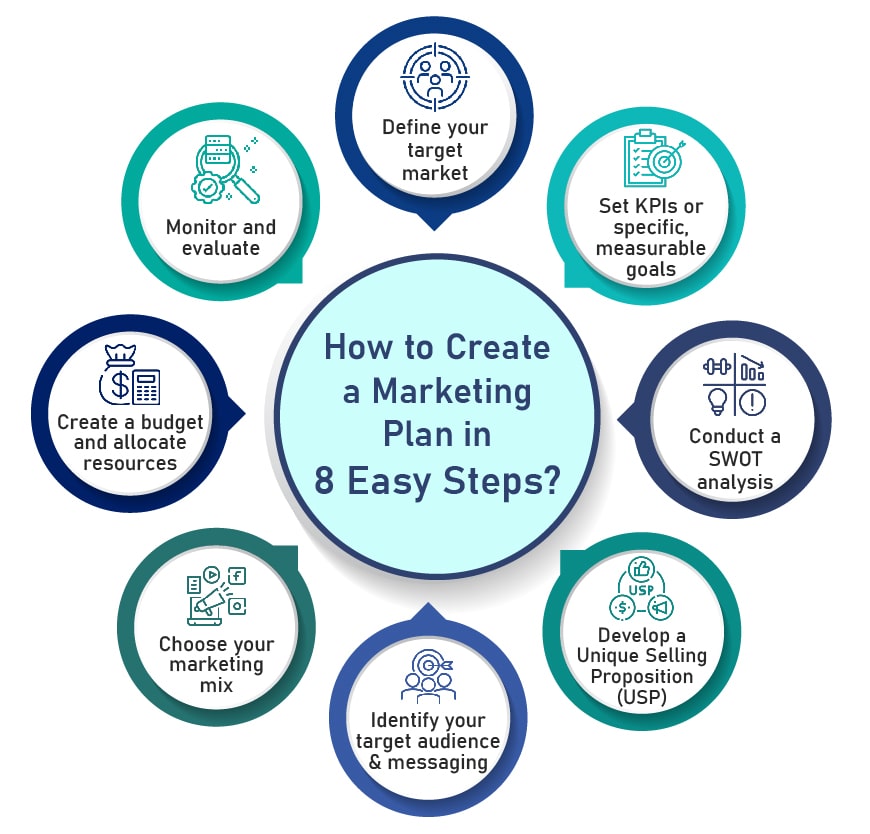In the ever-evolving landscape of business, a robust marketing plan is your compass, guiding your brand towards success. In this comprehensive blog, we’ll unravel the mysteries behind marketing plans, distinguish them from strategies, and walk you through the step-by-step process of creating your own. Whether you’re a seasoned entrepreneur or just starting, understanding these key elements is essential for steering your business in the right direction. In this blog we will explore all the basics and how to create marketing plans and strategies.
How to Create a Marketing Plan and What is it?

A marketing plan is a document that outlines a company’s overall marketing strategy, including goals, target audiences, and tactics for achieving those goals. It typically includes information on product or service positioning, pricing, distribution, promotion, and other key elements of the marketing mix. A marketing plan creation is often done on an annual basis but can be updated as needed to reflect changes in the market or the company’s business objectives. It is important for a business to have a marketing plan in order to stay organized, stay on track and make the most of its marketing budget.
What distinguishes a marketing plan from a marketing strategy?
A marketing plan and a marketing strategy are closely knit, but they are not the same thing. A marketing strategy is a strategic plan that outlines the roadmap of a company’s marketing goals. It is a general plan that defines the overall direction and approach for a company’s marketing efforts.
On the other hand, a marketing plan is a more detailed document that outlines the specific tactics and steps that will be taken to implement the marketing strategy. It includes information on how the company will allocate resources, such as budget and personnel, to execute the plan. A marketing plan also includes specific targets, metrics for measuring success, and timelines for implementing the various tactics.
In short, a marketing strategy is the what and why of a company’s marketing efforts, while a marketing plan is the how, when, and where.
Create a Marketing Plan in 8 Easy Steps

Define your target market:
Identify the specific group of customers you want to reach with your marketing efforts. Understand their demographics, behaviours, and needs. Learn about things like their age, interests, and what they need so you can communicate with them better.
Set KPIs or specific, measurable goals:
Identifying your key performance indicators (KPIs) enables you to track if your marketing plan is working in line with your business’s value proposition. For instance, if your objective is to interact with a certain demographic in a particular geography, you can monitor social media statistics and website traffic.
Conduct a SWOT Analysis:
Identify your company’s strengths, weaknesses, opportunities, and threats.
- Strengths: Identify and list the internal strengths that set your company apart, such as specialized skills, unique resources, or a strong brand.
- Weaknesses: Recognize internal aspects that may need improvement, such as limited resources, skill gaps, or operational inefficiencies.
- Opportunities: Explore external factors or trends that could benefit your company, such as emerging markets, technological advancements, or shifting consumer behaviors.
- Threats: Consider external factors that could pose challenges, such as competition, economic fluctuations, or regulatory changes. This analysis provides a comprehensive view, aiding in strategic decision-making and planning for the future.
Develop a Unique Selling Proposition (USP):
The value proposition defines how your product or service addresses the customer’s pain points, the benefits, and why they should choose your brand over your competitors. The marketing plan is designed in regard to this USP. Determine what distinguishes your product or service from the competitors.
Identify your target audience and messaging:
Determine the key messages you want to communicate to your target market. For instance, if you own a digital marketing firm or any startup, you could identify whether the business will run radio ads, social media ads, internet banner ads, or local TV commercials.
Choose your marketing mix:
Choose the particular methods and strategies you’ll employ to connect with your intended audience. This involves making decisions about how you’ll advertise, handle public relations, conduct direct marketing efforts, and utilize online marketing channels. Determine the most effective approaches based on your target market and overall marketing goals.
Create a budget and allocate resources:
Decide the budget allocation for each tactic and assign responsibilities for plan execution. This step is crucial to avoid unforeseen expenses and ensure a well-managed implementation of your marketing plan. Preventing runaway costs enhances financial control and increases the likelihood of achieving your marketing objectives within the set budget.
Monitor and evaluate:
Consistently evaluate the outcomes of your marketing endeavors and make adjustments as needed. This ongoing assessment ensures that your strategies remain effective and allows you to adapt to changing circumstances or emerging opportunities. Regular measurement and adjustment are key to optimizing your marketing efforts for sustained success.
It’s important to remember that a marketing plan is a living document and should be reviewed and updated regularly to reflect changes in the market and the company’s goals and objectives. Continuously customizing and optimizing a market plan is key to running a successful business as it can facilitate lead conversions and generate sales.
Conclusion
A marketing plan is a detailed guide for businesses, outlining the strategy, target audiences, goals, and specific tactics for effective marketing. It goes beyond a strategic vision, providing a blueprint for resource allocation, timelines, and measurable targets. The systematic eight-step process includes defining the target market, setting measurable goals, conducting a SWOT analysis, and choosing a tailored marketing mix.
Regular monitoring ensures the plan aligns with goals and market realities, while adapting to the evolving digital landscape enhances customer experiences and keeps brands competitive. Ultimately, a strategic and well-executed marketing plan sets the foundation for long-term growth and success.
Experience the transformative power of digital marketing for your business! Explore our website to find the best-suited options for your unique needs.
All images belong to their respective owners. Please email [email protected] if removal is required.




